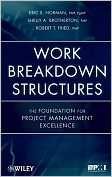| |||||
• polskie
• Zamów informacje o nowościach z wybranego tematu • kontakt |
WORK BREAKDOWN STRUCTURES THE FOUNDATION FOR PROJECT MANAGEMENT ...NORMAN E. BROTHERTON SH. FRIED R.wydawnictwo: WILEY, 2008, wydanie Icena netto: Understand and apply new concepts regarding Work Breakdown Structures The Work Breakdown Structure (WBS) has emerged as a foundational concept and tool in Project Management. It is an enabler that ensures clear definition and communication of project scope while performing a critical role as a monitoring a nd controlling tool. Created by the three experts who led the development of PMI's Practice Standard for Work Breakdown Structures, Second Edition, this much-needed text expands on what the standard covers and describes how to go about successfully implementing the WBS within the project life cycle, from initiation and planning through project closeout. Filling the gap in the literature on the WBS, Work Breakdown Structures: The Foundation for Project Management Excellence gives the reader an understanding of:
Using a real-life project as an example throughout the book, the authors show how the WBS first serves to document and collect information during the initiating and planning phases of a project. Then, during the executing phase, the authors demonstrate how the WBS transitions to an active role of project decision-support, serving as a reference and a source for control and measurement. Table of Contents
CHAPTER 1: BACKGROUND AND KEY CONCEPTS. Chapter Overview. The Role of the Work Breakdown Structure. Defining Work Breakdown Structure. The Importance of the WBS. A Brief Story as an Illustration. WBS Concepts. Defining the WBS. The House Metaphor: a Consistent Example. Chapter Summary. References. Chapter Quiz. CHAPTER 2: APPLYING WBS ATTRIBUTES AND CONCEPTS. Chapter Overview. WBS Attributes. WBS Core Characteristics. WBS Use-Related Characteristics. WBS Decomposition. WBS Uses beyond the Project. WBS Representations. WBS Tools. Chapter Summary. References. Chapter Quiz . CHAPTER 3: PROJECT INITIATION AND THE WBS. Chapter Overview. Project Charter. Preliminary Scope Statement. Contracts, Agreements, Statements of Work (SOW). Chapter Summary. References. Chapter Quiz. CHAPTER 4: DEFINING SCOPE THROUGH THE WBS. Chapter Overview. Product Scope Description. Project Scope Statement (Scope Definition). Work Breakdown Structure. Beginning with the Elaborated WBS. Use-Related Characteristics. WBS Dictionary. Deliverable-Based Management. Activity-Based Management. Scope Baseline. Acceptance Criteria. Chapter Summary. References. Chapter Quiz. CHAPTER 5: THE WBS IN PROCUREMENT AND FINANCIAL PLANNING. Chapter Overview. Build vs. Buy Decisions. Cost Estimating. Cost Budgeting. Cost Breakdown Structure. Chapter Summary . References. Chapter Quiz. CHAPTER 6: QUALITY, RISK, RESOURCE AND COMMUNICATION PLANNING WITH THE WBS. Chapter Overview. Approaching Quality, Resource and Risk Planning. Using Existing Templates and Processes. Creating Processes to Support the Project. Utilizing the WBS as a Basis for Process Development. Employing the WBS and WBS Dictionary. The Whole is not Greater than the Sum of it?s Parts: It Equals Precisely 100% of the Sum of it?s Parts. Process Considerations. Communications Planning Using the WBS as a Foundation. Developing the Communications Plan. The Communications Matrix. The Hierarchy of Information. The Meeting Matrix. Chapter Summary. References. Chapter Quiz. CHAPTER 7: THE WBS AS A STARTING POINT FOR SCHEDULE DEVELOPMENT. Chapter Overview. Demystifying the Transition from the WBS to the Project Schedule. Putting These Concepts to Work. The WBS in Hierarchical Outline Form. Identifying Dependencies between Scope Elements. Representing Scope Sequence and Dependency. Creating a High-Level Scope Sequence Representation. The Concept of Inclusion. The Scope Relationship Diagram. Creating a Scope Dependency Plan . Chapter Summary. References. Chapter Quiz. CHAPTER 8: THE WBS IN ACTION. Chapter Overview. Acquire Project Team. Direct and Manage Project Execution and Integrated Change Management. Scope Management. Scope Management and the Triple Constraint. Relationship with Other Project Management Processes. Perform Quality Assurance. Scope Verification. Chapter Summary. References. Chapter Quiz. CHAPTER 9: ENSURING SUCCESS THROUGH THE WBS. Chapter Overview. Project Performance Management. Scope. Schedule. Cost. Planned vs. Actual. Stakeholder Management. Chapter Summary. References. End of Chapter Quiz on Topics / Concepts. CHAPTER 10: VERIFYING PROJECT CLOSEOUT WITH THE WBS. Chapter Overview. Project Closeout. Acceptance / Turnover / Support / Maintenance. Contract Closure. Project Closeout. Chapter Summary. References. Chapter Quiz. CHAPTER 11: A PROJECT MANAGEMENT WBS. Chapter Overview. Organization Options for a Project Management WBS. Project Management WBS Components Aligned with the PMBOK? Guide: Third Edition. Project Management WBS Lite. Chapter Summary. Conclusion: A Final Word. References. Appendix A: Project Charter Example. Appendix B: Project Scope Statement Example. Appendix C: Project Management WBS Examples. Appendix D: Answers to Chapter Quizzes. Index. 304 pages, Hardcover Księgarnia nie działa. Nie odpowiadamy na pytania i nie realizujemy zamówien. Do odwolania !. |


